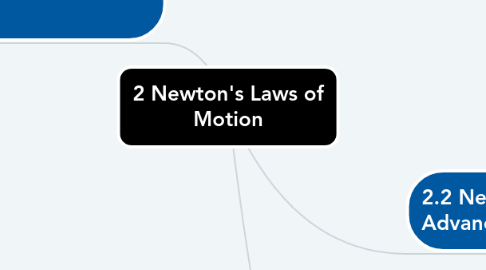
1. 2.1 Newton's Laws of Motion: Introduction
1.1. 2.1.1a Understand the First Law: Inertia
1.2. 2.1.1b Understand the Second Law: Force acting on an object
1.2.1. 2.1.1b1 Calculate, for an object moving in one dimension, the velocity change that results when a constant force F acts over a specified time interval
1.2.2. 2.1.1b2 Determine, for an object moving in a plane whose velocity vector undergoes a specified change over a specified time interval, the average force that acted on the object.
1.3. 2.1.1c Understand Newton’s Third Law: Force pairs
1.4. 2.1.2 Apply Newton’s Second Law
1.4.1. 2.1.2a Recognize the various forces acting on an object
1.4.2. 2.1.2b Draw a free-body diagram
1.4.3. 2.1.2c Analyze situations in which an object moves with specified acceleration under the influence of one or more forces
1.4.4. 2.2.2a Understand tension
2. 2.2 Newton's Laws of Motion: Advanced Concepts
2.1. 2.2.1a Understand significance of friction coefficient
2.1.1. 2.2.1a1 Write down the relationship between the normal and frictional forces on a surface.
2.1.2. 2.2.1a2 Analyze situations in which an object moves along a rough inclined plane or horizontal surface.
2.1.3. 2.2.1a3 Analyze under what circumstances an object will start to slip, or to calculate the magnitude of the force of static friction.
2.2. 2.2.1b Understand effect of drag forces
2.2.1. 2.2.1b1 Find the terminal velocity of an object moving vertically under the influence of a retarding force dependent on velocity.
2.2.2. 2.2.1b2 Describe qualitatively, with the aid of graphs, the acceleration, velocity, and displacement of such a particle when it is released from rest or is projected vertically with specified initial velocity.
2.3. 2.2.2 Apply Newton’s Third Law
2.3.1. 2.2.2b Apply Newton's laws to scenarios involving multiple bodies
2.3.2. 2.2.2 Determine the direction and magnitude of the force exerted by a spring
2.4. 2.2.3 Analyze situations with uniform circular motion
2.4.1. 2.2.3a Motion in a horizontal circle (e.g., mass on a rotating merry-go-round, or car rounding a banked curve).
2.4.2. 2.2.3b Motion in a vertical circle (e.g., mass swinging on the end of a string, cart rolling down a curved track, rider on a Ferris wheel).

